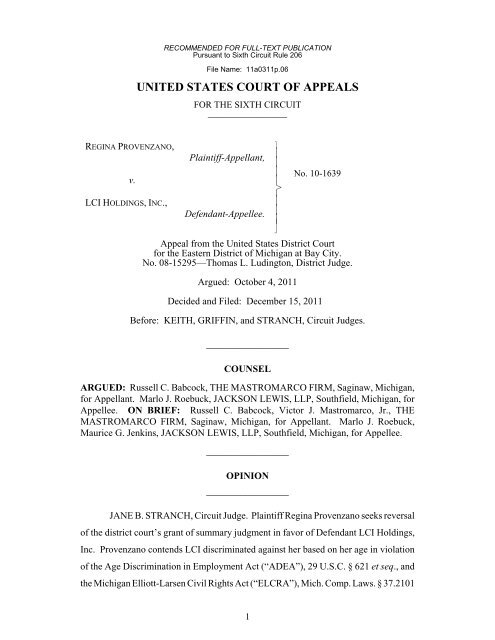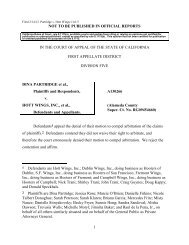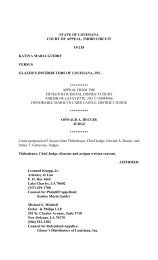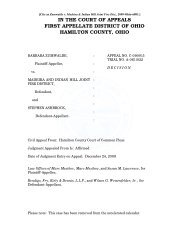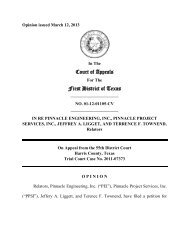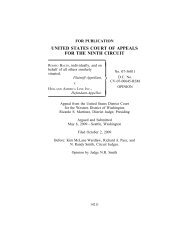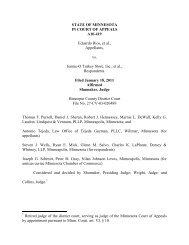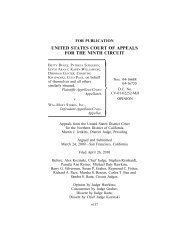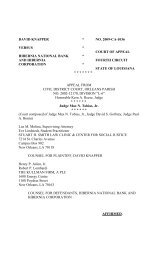From the court - Justia
From the court - Justia
From the court - Justia
You also want an ePaper? Increase the reach of your titles
YUMPU automatically turns print PDFs into web optimized ePapers that Google loves.
REGINA PROVENZANO,<br />
v.<br />
RECOMMENDED FOR FULL-TEXT PUBLICATION<br />
Pursuant to Sixth Circuit Rule 206<br />
File Name: 11a0311p.06<br />
UNITED STATES COURT OF APPEALS<br />
FOR THE SIXTH CIRCUIT<br />
_________________<br />
Plaintiff-Appellant,<br />
,<br />
LCI HOLDINGS, INC.,<br />
Defendant-Appellee.<br />
-<br />
-<br />
-<br />
N<br />
Appeal from <strong>the</strong> United States District Court<br />
for <strong>the</strong> Eastern District of Michigan at Bay City.<br />
No. 08-15295—Thomas L. Ludington, District Judge.<br />
X ----><br />
Argued: October 4, 2011<br />
No. 10-1639<br />
Decided and Filed: December 15, 2011<br />
Before: KEITH, GRIFFIN, and STRANCH, Circuit Judges.<br />
_________________<br />
COUNSEL<br />
ARGUED: Russell C. Babcock, THE MASTROMARCO FIRM, Saginaw, Michigan,<br />
for Appellant. Marlo J. Roebuck, JACKSON LEWIS, LLP, Southfield, Michigan, for<br />
Appellee. ON BRIEF: Russell C. Babcock, Victor J. Mastromarco, Jr., THE<br />
MASTROMARCO FIRM, Saginaw, Michigan, for Appellant. Marlo J. Roebuck,<br />
Maurice G. Jenkins, JACKSON LEWIS, LLP, Southfield, Michigan, for Appellee.<br />
_________________<br />
OPINION<br />
_________________<br />
JANE B. STRANCH, Circuit Judge. Plaintiff Regina Provenzano seeks reversal<br />
of <strong>the</strong> district <strong>court</strong>’s grant of summary judgment in favor of Defendant LCI Holdings,<br />
Inc. Provenzano contends LCI discriminated against her based on her age in violation<br />
of <strong>the</strong> Age Discrimination in Employment Act (“ADEA”), 29 U.S.C. § 621 et seq., and<br />
<strong>the</strong> Michigan Elliott-Larsen Civil Rights Act (“ELCRA”), Mich. Comp. Laws. § 37.2101<br />
1
No. 10-1639 Provenzano v. LCI Holdings, Inc. Page 2<br />
et seq. Although <strong>the</strong> district <strong>court</strong> misapplied <strong>the</strong> prima facie analysis for a failure to<br />
promote discrimination claim, <strong>the</strong> district <strong>court</strong>’s grant of summary judgment is<br />
AFFIRMED because Provenzano has not proven pretext.<br />
I. BACKGROUND<br />
Regina Provenzano was born on September 24, 1958 and has a high school<br />
diploma and an associate’s degree in retail management. In 1997, at age thirty-nine,<br />
Provenzano started working for LCI as a sales associate in its Liz Claiborne Outlet store<br />
in Birch Run, Michigan, in LCI’s Midwest District. Approximately two years later,<br />
Provenzano was promoted to a full-time supervisor position by <strong>the</strong>n-assistant manager<br />
Erica Hall. Provenzano also occasionally traveled to assist o<strong>the</strong>r stores that were just<br />
opening.<br />
On April 13, 2008, Judy Babcock (age thirty-three) was promoted to assistant<br />
manager at <strong>the</strong> Birch Run store. The store manager, Connie Romanetto (age sixty-one),<br />
recommended Babcock for <strong>the</strong> promotion and <strong>the</strong>n-district manager Erica Hall approved<br />
<strong>the</strong> recommendation. The open position was not publicized to any employees and<br />
Provenzano was not asked to, nor did she, apply for <strong>the</strong> position. Provenzano alleges she<br />
was more qualified than Babcock for <strong>the</strong> promotion because she had worked at <strong>the</strong> store<br />
longer and had a high school diploma and an associate’s degree, whereas Babcock had<br />
nei<strong>the</strong>r. Hall testified that Babcock was a superior candidate because she met more of<br />
<strong>the</strong> performance qualifications on <strong>the</strong> job description than did Provenzano.<br />
Throughout 2007 and 2008, due to economic conditions, LCI underwent<br />
company-wide restructuring, directed at reducing costs by aligning each store’s<br />
projected sales volume with a template-based mix of non-supervisory and supervisory<br />
positions. The plan was executed in two phases: one in February 2007 and one in June<br />
2008. In <strong>the</strong> Birch Run store in 2007, two full-time associates in <strong>the</strong>ir twenties were<br />
reduced to part-time associates; Provenzano was not impacted during this phase. In June<br />
2008, LCI eliminated <strong>the</strong> full-time supervisor position in <strong>the</strong> Midwest District and<br />
reduced many employees holding such position to part-time supervisors. Five of those
No. 10-1639 Provenzano v. LCI Holdings, Inc. Page 3<br />
eleven full-time supervisors were under <strong>the</strong> age of forty. While <strong>the</strong> o<strong>the</strong>r supervisors<br />
transitioned in June, Hall permitted Provenzano to postpone her reduction to part-time<br />
supervisor until July in order to utilize <strong>the</strong> medical benefits for an additional month.<br />
Hall testified that in late July 2008 she told store manager Romanetto that she<br />
could improve her performance and remain store manager or step down from <strong>the</strong><br />
position. When Romanetto elected to assume an assistant manager position, twenty-<br />
eight-year-old Summer Kennard transferred into <strong>the</strong> store manager position, leaving <strong>the</strong><br />
Birch Run store with six management-level employees. Hall testified that because LCI’s<br />
restructuring mandate permitted only four, in August 2008 she offered Sanburn and<br />
Provenzano <strong>the</strong> option to step down as part-time supervisors and accept positions as<br />
part-time sales associates or leave <strong>the</strong> company. Both chose to step down. Provenzano<br />
testified that her reduced hours and pay compelled her to resign her position with LCI<br />
as of November 10, 2008.<br />
On November 26, 2008, Provenzano filed a complaint alleging age<br />
discrimination under <strong>the</strong> ELCRA against LCI in Saginaw County Circuit Court. On<br />
January 2, 2009, LCI removed <strong>the</strong> case to federal <strong>court</strong>, and Provenzano amended her<br />
complaint to include a cause of action under <strong>the</strong> ADEA. After discovery, LCI moved<br />
for summary judgment. 1 On April 12, 2010, <strong>the</strong> district <strong>court</strong> granted LCI’s motion.<br />
Specifically, <strong>the</strong> <strong>court</strong> applied <strong>the</strong> McDonnell Douglas burden-shifting framework to<br />
Provenzano’s claims and found she had failed to satisfy <strong>the</strong> fourth prong of her prima<br />
facie case, and had failed to prove pretext in <strong>the</strong> face of LCI’s nondiscriminatory reasons<br />
for <strong>the</strong> promotional decision. Provenzano appeals both determinations.<br />
1 In her response, Provenzano clarified that her age discrimination claim is based on LCI’s<br />
decision to promote Judy Babcock to <strong>the</strong> position of assistant manager instead of Provenzano and that all<br />
“o<strong>the</strong>r acts of discrimination alluded to in [LCI’s] brief and discussed in more detail in [Provenzano’s]<br />
response are meant to place <strong>the</strong> decision to deny <strong>the</strong> promotion to [Provenzano] into context.”
No. 10-1639 Provenzano v. LCI Holdings, Inc. Page 4<br />
A. Standard of Review<br />
II. DISCUSSION<br />
This Court reviews a district <strong>court</strong>’s grant of summary judgment de novo. Geiger<br />
v. Tower Auto., 579 F.3d 614, 620 (6th Cir. 2009). Summary judgment is appropriate<br />
if <strong>the</strong>re is no genuine issue as to any material fact and <strong>the</strong> movant is entitled to judgment<br />
as a matter of law. Fed. R. Civ. P. 56(a) (2010). The moving party has <strong>the</strong> burden of<br />
proving <strong>the</strong> absence of a genuine issue of material fact and its entitlement to summary<br />
judgment as a matter of law. Celtex Corp. v. Catrett, 477 U.S. 317, 323 (1986). All<br />
facts, including inferences, are viewed in <strong>the</strong> light most favorable to <strong>the</strong> nonmoving<br />
party. Matsushita Elec. Indus. Co. v. Zenith Radio Corp., 475 U.S. 574, 587 (1986).<br />
The central issue is “whe<strong>the</strong>r <strong>the</strong> evidence presents a sufficient disagreement to require<br />
submission to a jury or whe<strong>the</strong>r it is so one-sided that one party must prevail as a matter<br />
of law.” Wexler v. White’s Fine Furniture, Inc., 317 F.3d 564, 570 (6th Cir. 2003) (en<br />
banc) (citing Anderson v. Liberty Lobby, Inc., 477 U.S. 242, 251-52 (1986)). LCI moved<br />
for summary judgment, <strong>the</strong>refore this Court must view <strong>the</strong> evidence in <strong>the</strong> light most<br />
favorable to Provenzano and draw all reasonable inferences in her favor in determining<br />
whe<strong>the</strong>r <strong>the</strong>re exists a dispute of material fact for submittal to a jury.<br />
B. ADEA Claim<br />
The ADEA prohibits an employer from failing or refusing to hire, discharging,<br />
or discriminating “against any individual with respect to his compensation, terms,<br />
conditions, or privileges of employment, because of such individual’s age.” 29 U.S.C.<br />
§ 623(a)(1). A plaintiff may establish a violation of <strong>the</strong> ADEA by ei<strong>the</strong>r direct or<br />
circumstantial evidence. Gieger, 579 F.3d at 620. “Direct evidence of discrimination<br />
is that evidence which, if believed, requires <strong>the</strong> conclusion that unlawful discrimination<br />
was at least a motivating factor in <strong>the</strong> employer’s actions.” Wexler, 317 F.3d at 570<br />
(citation and internal quotation marks omitted). “Circumstantial evidence, on <strong>the</strong> o<strong>the</strong>r<br />
hand, is proof that does not on its face establish discriminatory animus, but does allow<br />
a factfinder to draw a reasonable inference that discrimination occurred.” Id.
No. 10-1639 Provenzano v. LCI Holdings, Inc. Page 5<br />
Regardless of <strong>the</strong> type of evidence submitted, <strong>the</strong> burden of persuasion remains on<br />
ADEA plaintiffs to demonstrate “that age was <strong>the</strong> ‘but-for’ cause of <strong>the</strong>ir employer’s<br />
adverse action.” Gross v. FBL Fin. Servs., Inc., 129 S. Ct. 2343, 2351 n.4 (2009).<br />
Provenzano relied entirely on circumstantial evidence. The three-step framework<br />
developed in McDonnell Douglas Corp. v. Green, 411 U.S. 792 (1973), and modified<br />
by Texas Dep’t of Community Affairs v. Burdine, 450 U.S. 248 (1981), guides <strong>the</strong><br />
analysis of age discrimination claims based upon circumstantial evidence. Ercegovich<br />
v. Goodyear Tire & Rubber Co., 154 F.3d 344, 350 (6th Cir. 1998). In <strong>the</strong> first step, <strong>the</strong><br />
employee carries <strong>the</strong> initial burden of establishing a prima facie case of age<br />
discrimination; if <strong>the</strong> employee meets this burden, <strong>the</strong> second step requires <strong>the</strong> employer<br />
to respond by articulating some legitimate, nondiscriminatory reason for <strong>the</strong> adverse<br />
employment action at issue. McDonnell Douglas, 411 U.S. at 802. Third, assuming<br />
such a response is made, <strong>the</strong> employee <strong>the</strong>n bears <strong>the</strong> burden of rebutting this proffered<br />
reason by proving that it was pretext designed to mask discrimination. Id. at 804.<br />
This “three-part inquiry provides ‘an allocation of <strong>the</strong> burden of production and<br />
an order for <strong>the</strong> presentation of proof in [employment discrimination] cases.’” Cline v.<br />
Catholic Diocese of Toledo, 206 F.3d 651, 659 (6th Cir. 2000) (citing St. Mary’s Honor<br />
Ctr. v. Hicks, 509 U.S. 502, 506 (1993)). At all times, <strong>the</strong> ultimate burden of persuasion<br />
remains on <strong>the</strong> plaintiff to demonstrate that age was <strong>the</strong> “but-for” cause of <strong>the</strong>ir<br />
employer’s adverse action. See Burdine, 450 U.S. at 253. At no time does <strong>the</strong> defendant<br />
carry <strong>the</strong> burden of persuasion. In contrast, <strong>the</strong> burden of production shifts between<br />
litigants as <strong>the</strong> analysis advances.<br />
This Court has explained <strong>the</strong> relevant burdens at <strong>the</strong> summary judgment stage:<br />
On a motion for summary judgment, a district <strong>court</strong> considers whe<strong>the</strong>r<br />
<strong>the</strong>re is sufficient evidence to create a genuine dispute at each stage of<br />
<strong>the</strong> McDonnell Douglas inquiry.” Cline v. Catholic Diocese of Toledo,<br />
206 F.3d 651, 661 (6th Cir. 2000). Thus, <strong>the</strong> plaintiff must first submit<br />
evidence from which a reasonable jury could conclude that a prima facie<br />
case of discrimination has been established. Monette v. Elec. Data Sys.<br />
Corp., 90 F.3d 1173, 1186 (6th Cir. 1996). The defendant must <strong>the</strong>n<br />
offer sufficient evidence of a legitimate, nondiscriminatory reason for its
No. 10-1639 Provenzano v. LCI Holdings, Inc. Page 6<br />
action. Id. If <strong>the</strong> defendant does so, <strong>the</strong> plaintiff must identify evidence<br />
from which a reasonable jury could conclude that <strong>the</strong> proffered reason is<br />
actually a pretext for unlawful discrimination. Id.<br />
Macy v. Hopkins Cnty. Sch. Bd. of Educ., 484 F.3d 357, 364 (6th Cir. 2007). The<br />
plaintiff’s burden to demonstrate pretext in <strong>the</strong> final step <strong>the</strong>n “merges with <strong>the</strong> ultimate<br />
burden of persuading <strong>the</strong> <strong>court</strong> that she has been <strong>the</strong> victim of intentional<br />
discrimination.” Burdine, 450 U.S. at 256. In evaluating pretext and <strong>the</strong> plaintiff’s<br />
ultimate burden, <strong>the</strong> <strong>court</strong> should consider all evidence in <strong>the</strong> light most favorable to <strong>the</strong><br />
plaintiff, including <strong>the</strong> evidence presented in <strong>the</strong> prima facie stage. See Peck v. Elyria<br />
Foundry Co., 347 F. App’x 139, 145 (6th Cir. 2009) (citing Hicks, 509 U.S. at 511).<br />
The district <strong>court</strong> first held that Provenzano did not establish a prima facie case<br />
of age discrimination under McDonnell Douglas. Provenzano disputes this finding.<br />
1. Prima Facie Stage<br />
In <strong>the</strong> first stage of <strong>the</strong> McDonnell Douglas analysis, Provenzano must establish<br />
a prima facie case of discrimination. To make out a prima facie case of age<br />
discrimination based on LCI’s failure to promote her, Provenzano must show that (1) she<br />
is a member of <strong>the</strong> protected class; (2) she applied for and was qualified for a promotion;<br />
(3) she was considered for and was denied <strong>the</strong> promotion; and (4) o<strong>the</strong>r employees of<br />
similar qualifications who were not members of <strong>the</strong> protected class received promotions<br />
at <strong>the</strong> time <strong>the</strong> plaintiff’s request for promotion was denied. White v. Columbus Metro.<br />
Hous. Auth., 429 F.3d 232, 240 (6th Cir. 2005) (citing Nguyen v. City of Cleveland, 229<br />
F.3d 559, 562-63 (6th Cir. 2000)); cf. Brennan v. Tractor Supply Co., 237 F. App’x 9,<br />
16 (6th Cir. 2007). 2 Provenzano’s burden at <strong>the</strong> prima facie stage is “not onerous” and<br />
“poses a burden easily met.” Cline, 206 F.3d at 660 (citing Burdine, 450 U.S. at 253).<br />
2 The fourth element in Brennan differs slightly from that in White by requiring a plaintiff in a<br />
failure to promote claim to show that similarly-situated employees not in <strong>the</strong> plaintiff’s protected class<br />
received promotions. Although Brennan is an ADEA case and White is a Title VII case, this Court has<br />
clearly rejected <strong>the</strong> “similarly situated” language in a failure to promote claim in favor of <strong>the</strong> language<br />
established in Nguyen. White, 429 F.3d at 241. Nguyen places <strong>the</strong> proper emphasis on <strong>the</strong> relative<br />
qualifications of <strong>the</strong> plaintiff and <strong>the</strong> promoted individual. Id. at 240-41.
No. 10-1639 Provenzano v. LCI Holdings, Inc. Page 7<br />
The prima facie case is meant simply to force a defendant to proceed with its case. Id.<br />
at 660 (citation omitted).<br />
We would do well to pause here and admit that while <strong>the</strong> burden-shifting analysis<br />
of McDonnell Douglas was created to assist in <strong>the</strong> presentation of a discrimination case,<br />
it often fails to fulfill its purpose. That failure is particularly pronounced in <strong>the</strong> context<br />
of summary judgment where <strong>the</strong> burden-shifting analysis can obfuscate <strong>the</strong> appropriate<br />
question—whe<strong>the</strong>r <strong>the</strong>re exists a genuine issue of material fact. Even if that over-<br />
arching question is given its due, opportunities abound for confusion in applying <strong>the</strong><br />
three stage formula to <strong>the</strong> evidence in a case. “While <strong>the</strong> discrete stages are meant to<br />
facilitate litigants and <strong>court</strong>s in reaching and resolving that ultimate question of<br />
discrimination, when misapplied, <strong>the</strong>y tend to distract <strong>court</strong>s from <strong>the</strong> central issue.”<br />
Cline, 206 F.3d at 660. One common misapplication is <strong>the</strong> tendency to push all of <strong>the</strong><br />
evidence into <strong>the</strong> prima facie stage and ignore <strong>the</strong> purpose for and application of <strong>the</strong><br />
three stages. Such was <strong>the</strong> problem here.<br />
The district <strong>court</strong> merged its analysis of <strong>the</strong> second (nondiscriminatory<br />
justification) and third (pretext) stages of <strong>the</strong> McDonnell Douglas test into its evaluation<br />
of Provenzano’s prima facie case. 3 This is clear from <strong>the</strong> one-sentence analysis of <strong>the</strong><br />
latter two stages: “For <strong>the</strong> same reasons that Plaintiff cannot establish <strong>the</strong> fourth element<br />
of a prima facie case of age discrimination, Plaintiff cannot establish pretext.”<br />
Provenzano v. LCI Holdings, Inc., No. 08-15295-BC, 2010 WL 1462937 at *7 (E.D.<br />
Mich. Apr. 12, 2010). This was error.<br />
We now turn to analysis of <strong>the</strong> evidence appropriate to <strong>the</strong> prima facie stage of<br />
this failure to promote case. We begin by examining Provenzano’s qualifications in both<br />
<strong>the</strong> second (qualification) and fourth (comparison to promoted employee) prongs. White,<br />
429 F.3d at 242–43. However, this evaluation must be conducted independently of<br />
LCI’s proffered nondiscriminatory reason and must not conflate <strong>the</strong> prima facie and<br />
3 It considered such evidence as LCI’s workforce-reduction justifications (properly to be presented<br />
by LCI at <strong>the</strong> second stage to show its legitimate, nondiscriminatory purpose) and Provenzano’s failure<br />
to present evidence of motive o<strong>the</strong>r than Romanetto’s jealousy (properly a challenge to Provenzano’s<br />
burden to show pretext at <strong>the</strong> third stage).
No. 10-1639 Provenzano v. LCI Holdings, Inc. Page 8<br />
pretext stages of <strong>the</strong> McDonnell Douglas test. Id. at 242. An important function of <strong>the</strong><br />
prima facie test is to eliminate <strong>the</strong> most common nondiscriminatory reasons for <strong>the</strong><br />
employer’s action. See Burdine, 450 U.S. at 253-54. Therefore, a general weighing of<br />
<strong>the</strong> qualifications of Provenzano and Babcock is necessary at <strong>the</strong> prima facie stage;<br />
however, this light review must be distinguished from <strong>the</strong> more rigorous comparison<br />
conducted at <strong>the</strong> later stages of <strong>the</strong> McDonnell Douglas analysis. See Burdine, 450 U.S.<br />
at 255 (after <strong>the</strong> defendant raises a legitimate nondiscriminatory reason, “<strong>the</strong> factual<br />
inquiry proceeds to a new level of specificity”). As noted in White, this careful<br />
distinction is especially necessary in cases such as this one, where <strong>the</strong> employer asserts<br />
as its nondiscriminatory reason for failing to promote <strong>the</strong> plaintiff that it chose to hire<br />
a candidate it considered more qualified. See White, 429 F.3d at 247 (Moore, J.,<br />
concurring).<br />
There is no dispute that Provenzano satisfied <strong>the</strong> first three elements of <strong>the</strong> prima<br />
facie stage; only <strong>the</strong> fourth element is at issue. Provenzano contends that <strong>the</strong> fourth<br />
element of <strong>the</strong> prima facie case should be satisfied by showing merely that a younger<br />
person was promoted to a position instead of Provenzano. This Court directly<br />
considered and rejected Provenzano’s argument in White, holding that “it is insufficient<br />
for a plaintiff in a failure to promote [discrimination] case merely to point to [a non-<br />
protected person] who received <strong>the</strong> job in satisfying <strong>the</strong> fourth prong.” White, 429 F.3d<br />
at 241. This Court emphasized that “it is incumbent upon <strong>the</strong> plaintiff to establish that<br />
she and <strong>the</strong> non-protected person who ultimately was hired for <strong>the</strong> desired position had<br />
similar qualifications.” Id. at 242.<br />
In a failure to promote claim, <strong>the</strong> emphasis in <strong>the</strong> fourth element is on <strong>the</strong> relative<br />
qualifications of <strong>the</strong> plaintiff and <strong>the</strong> employee who actually received <strong>the</strong> promotion.<br />
White, 429 F.3d at 240-41. The prima facie burden is not intended to be onerous, Cline,<br />
206 F.3d at 660 (citing Burdine, 450 U.S. at 253), and Provenzano is not required to<br />
establish that she and Babcock had <strong>the</strong> exact same qualifications. Requiring a plaintiff<br />
to show identical qualifications to ano<strong>the</strong>r individual is not realistic from a human<br />
standpoint. We recognized this practical reality in Ercegovich, rejecting an exact
No. 10-1639 Provenzano v. LCI Holdings, Inc. Page 9<br />
matching requirement for “similarly-situated” comparators in an ADEA claim. 154 F.3d<br />
at 352-53. Instead, what is required in a failure to promote case is for <strong>the</strong> plaintiff to<br />
show she possesses “similar qualifications” to <strong>the</strong> employee who received <strong>the</strong><br />
promotion.<br />
A comparison of Provenzano and Babcock reveals that Provenzano presented<br />
sufficient evidence to permit a reasonable trier of fact to conclude that she and Babcock<br />
were similarly qualified for <strong>the</strong> position of assistant manager. Provenzano had more<br />
experience and education than Babcock; she had been a supervisor longer, had helped<br />
in o<strong>the</strong>r stores, and held a high school diploma and associate’s degree. In contrast,<br />
Babcock had a stronger performance record, without any written or verbal warnings in<br />
comparison to Provenzano’s multiple counselings. Although <strong>the</strong>ir strengths and<br />
weaknesses were in different areas, Provenzano’s experience and education made her<br />
similarly qualified to Babcock. This is <strong>the</strong> extent of <strong>the</strong> inquiry at <strong>the</strong> prima facie stage<br />
and Provenzano satisfied it.<br />
2. Nondiscriminatory Justification<br />
Once <strong>the</strong> plaintiff meets her prima facie burden, <strong>the</strong> burden of production shifts<br />
to <strong>the</strong> employer to articulate a legitimate nondiscriminatory reason for failing to promote<br />
<strong>the</strong> plaintiff to <strong>the</strong> position sought. Burdine, 450 U.S. at 254; White, 429 F.3d at 244.<br />
LCI is not required to persuade <strong>the</strong> <strong>court</strong> that it was actually motivated by <strong>the</strong> proffered<br />
reasons. Burdine, 450 U.S. at 254. Ra<strong>the</strong>r, it is sufficient for LCI to raise a genuine<br />
issue of fact as to whe<strong>the</strong>r it discriminated against Provenzano. Id. In order to<br />
accomplish this, LCI must clearly set forth, through <strong>the</strong> introduction of admissible<br />
evidence, <strong>the</strong> reasons for not promoting Provenzano. Id. at 255.<br />
This stage of <strong>the</strong> McDonnell Douglas framework is where it is appropriate to<br />
consider district manager Hall’s and former store manager Romanetto’s opinions of<br />
Provenzano as compared with Babcock. LCI has asserted that it chose not to promote<br />
Provenzano because it decided to promote a more qualified candidate and because it felt<br />
that Provenzano’s performance record rendered her unpromotable to assistant manager.<br />
In Hall’s deposition and affidavit, she gave a detailed description of Babcock’s
No. 10-1639 Provenzano v. LCI Holdings, Inc. Page 10<br />
performance-related attributes and Provenzano’s performance-related deficiencies. The<br />
district <strong>court</strong> properly found that LCI met its burden of production at this second stage<br />
of <strong>the</strong> McDonnell Douglas analysis.<br />
3. Pretext<br />
In <strong>the</strong> third and final stage of <strong>the</strong> McDonnel Douglas analysis, <strong>the</strong> presumption<br />
of discrimination is gone and <strong>the</strong> plaintiff must demonstrate that <strong>the</strong> employer’s<br />
proffered nondiscriminatory reason was not <strong>the</strong> true reason for <strong>the</strong> employment decision,<br />
but ra<strong>the</strong>r a pretext for discrimination. Burdine, 450 U.S. at 256. A plaintiff can refute<br />
<strong>the</strong> legitimate, nondiscriminatory reason that an employer offers to justify an adverse<br />
employment action “by showing that <strong>the</strong> proffered reason (1) has no basis in fact, (2) did<br />
not actually motivate <strong>the</strong> defendant’s challenged conduct, or (3) was insufficient to<br />
warrant <strong>the</strong> challenged conduct.” Wexler, 317 F.3d at 576 (quoting Dews v. A.B. Dick<br />
Co., 231 F.3d 1016, 1021 (6th Cir. 2000)).<br />
LCI asserts that Hall based her decision not to promote Provenzano on<br />
Provenzano’s deficient performance record and <strong>the</strong> existence of a more qualified<br />
candidate. Provenzano offered several reasons in support of finding LCI’s justifications<br />
pretextual: Babcock’s lack of a high school education; Provenzano’s experience<br />
assisting o<strong>the</strong>r stores; a history of promotions, transfers, and demotions that Provenzano<br />
alleges evidences a pattern of discriminating against older employees; and a corporate<br />
email referencing <strong>the</strong> target customer’s age group.<br />
Provenzano’s first two grounds for finding pretext involve <strong>the</strong> relative<br />
qualifications of Provenzano and Babcock. “Relative qualifications establish triable<br />
issues of fact as to pretext where <strong>the</strong> evidence shows that ei<strong>the</strong>r (1) <strong>the</strong> plaintiff was a<br />
plainly superior candidate, such that no reasonable employer would have chosen <strong>the</strong><br />
latter applicant over <strong>the</strong> former, or (2) plaintiff was as qualified as if not better qualified<br />
than <strong>the</strong> successful applicant, and <strong>the</strong> record contains ‘o<strong>the</strong>r probative evidence of<br />
discrimination.’” Bartlett v. Gates, 421 F. App’x 485, 490-91 (6th Cir. 2010) (citing<br />
Bender v. Hecht’s Dep’t Stores, 455 F.3d 612, 627-28 (6th Cir. 2006)).
No. 10-1639 Provenzano v. LCI Holdings, Inc. Page 11<br />
Provenzano claims pretext arguing that Babcock cannot be qualified because she<br />
lacks a high school diploma. The job description for <strong>the</strong> assistant manager position lists<br />
“High school Diploma and equivalent retail fashion management experience; College<br />
Degree a plus.” Provenzano argues this makes a high school diploma a mandatory<br />
qualification, making her a plainly superior candidate. Hall testified that she mistakenly<br />
believed at <strong>the</strong> time of <strong>the</strong> promotion that Babcock possessed a high school diploma.<br />
Provenzano testified that Romanetto suggested o<strong>the</strong>rwise. However, whe<strong>the</strong>r Hall or<br />
Romanetto knew of Babcock’s lack of a high school diploma is not decisive because<br />
Babcock was not unqualified for <strong>the</strong> position merely because she lacked a high school<br />
diploma.<br />
The assistant manager job description lists over forty “Knowledge, Skills and<br />
Abilities.” The job description does not indicate and no evidence, except Provenzano’s<br />
personal belief, suggests that any of <strong>the</strong> listed qualifications was mandatory or weighed<br />
more heavily in <strong>the</strong> promotion process. In fact, Hall asserts that Provenzano lacks both<br />
good communication skills and an ability to partner with superiors, which are two of <strong>the</strong><br />
o<strong>the</strong>r “Knowledge” qualifications listed along with <strong>the</strong> educational qualification. Under<br />
Provenzano’s analysis, nei<strong>the</strong>r she nor Babcock would be qualified. Because no<br />
particular qualification was mandatory, Babcock’s lack of a high school diploma alone<br />
does not establish that “no reasonable employer would have chosen [Babcock] over<br />
[Provenzano].” See Bartlett, 421 F. App’x at 490-91.<br />
Provenzano also argues LCI’s claim that Provenzano was not promotable is<br />
pretextual because LCI chose Provenzano to assist o<strong>the</strong>r Liz Claiborne stores.<br />
Provenzano testified:<br />
I went to stores that were in dire need of help that didn’t have a full staff<br />
and I helped <strong>the</strong>m get <strong>the</strong>ir stuff—you know, <strong>the</strong>ir store back in order<br />
and I could do all this, but yet I couldn’t be an assistant manager. I<br />
didn’t understand it.<br />
I would go to Colorado for a month at a time. They didn’t have a<br />
manager and I would literally run <strong>the</strong> store, and get it up on its feet and<br />
get—you know, until <strong>the</strong>y hired a manager. They called me a lot to go<br />
to different places, Colorado, all over Utah. And I did a lot for this<br />
company but yet <strong>the</strong>y didn’t promote me and I felt that that was wrong.
No. 10-1639 Provenzano v. LCI Holdings, Inc. Page 12<br />
Provenzano alleges she performed many of <strong>the</strong> responsibilities of an assistant manager<br />
while traveling to those stores and this demonstrated her competency as well as LCI’s<br />
approval of her in that role.<br />
Hall does not contest Provenzano’s qualification to travel to assist o<strong>the</strong>r stores.<br />
Instead, Hall asserts that it was Provenzano’s “performance issues” that made her not<br />
promotable. In explaining <strong>the</strong> promotional decision process, Hall stated<br />
People are rated on <strong>the</strong>ir performance on not only a daily basis, a weekly<br />
basis, but a monthly basis, and even though someone may have<br />
performed at one level at one time, if <strong>the</strong>re is not a consistency over a<br />
certain time period or <strong>the</strong>re’s issues that may come up, when decision<br />
time is made, when it’s time to make <strong>the</strong> decision, <strong>the</strong> best decision is<br />
going to be made that’s going to be appropriate and it’s going to be based<br />
on performance.<br />
In essence, LCI takes <strong>the</strong> position that Provenzano was not <strong>the</strong> most attractive candidate<br />
at <strong>the</strong> time of promotion, not that she was categorically unqualified for <strong>the</strong> assistant<br />
manager job. Therefore, Provenzano’s experience assisting o<strong>the</strong>r stores does not<br />
conclusively establish that she should have been promoted over ano<strong>the</strong>r candidate<br />
without that experience and does not establish that “no reasonable employer would have<br />
chosen [Babcock] over [Provenzano].” See Bartlett, 421 F. App’x at 490-91.<br />
In order to present a triable issue of fact as to pretext, Provenzano could also<br />
show that she was as qualified as, if not better qualified than, Babcock, along with proof<br />
of “o<strong>the</strong>r probative evidence of discrimination.” Id. A more searching evaluation of <strong>the</strong><br />
relative qualifications of <strong>the</strong> two candidates is conducted at this stage than was required<br />
at <strong>the</strong> fourth prong of <strong>the</strong> prima facie case. See Burdine, 450 U.S. at 255. Although<br />
Provenzano had been with LCI for only three years longer than Babcock, Provenzano<br />
had six more years of experience in retail sales supervision, as well as experience<br />
assisting o<strong>the</strong>r stores. In addition, Provenzano possessed superior educational<br />
credentials, including an associate’s degree in an area relevant to <strong>the</strong> promotion position.<br />
Babcock, however, had a much stronger performance record during her time with<br />
LCI than did Provenzano. Babcock had no disciplinary warning, while Provenzano had
No. 10-1639 Provenzano v. LCI Holdings, Inc. Page 13<br />
several, both written and verbal, in her personnel file. These warnings pertained to<br />
violations of LCI’s security policy, which Hall testified were violations of one of <strong>the</strong><br />
“top security rules,” permitting automatic advancement in <strong>the</strong> disciplinary process to <strong>the</strong><br />
final written warning stage, <strong>the</strong> next stage being termination. Provenzano had also been<br />
counseled on her failure to partner with superiors and her poor communication skills.<br />
In contrast, Babcock received positive feedback from employees and customers and was<br />
praised by Hall as having proper communication skills, being reliable, creating displays<br />
that were visually appealing, providing good results for <strong>the</strong> store, and having a positive<br />
attitude. Under <strong>the</strong>se facts one could argue that Provenzano may not be as qualified as<br />
Babcock for promotion to a position that required significant interpersonal skills and <strong>the</strong><br />
ability not just to follow, but also enforce, company policies and rules. However, even<br />
assuming equal qualifications, Provenzano must also show “o<strong>the</strong>r probative evidence of<br />
discrimination.” See Bender, 455 F.3d at 627-28.<br />
As fur<strong>the</strong>r evidence of discrimination, Provenzano points to LCI’s record of<br />
promotions, transfers, and demotions of o<strong>the</strong>r members of management and <strong>the</strong> contents<br />
of a corporate email received at some point during <strong>the</strong> summer after Babcock’s<br />
promotion. Provenzano notes that as of January 1, 2008, individuals of <strong>the</strong> following<br />
ages held management positions at LCI’s Birch Run store: 61, 51, 49, and 41; but, by<br />
August or September 2008, <strong>the</strong> ages of management were: 61, 41, 34, and 27. While<br />
Romanetto (age 61) was on a leave of absence for medical reasons, 30-year-old Annetta<br />
Kucab filled in as a part-time supervisor while continuing her duties at ano<strong>the</strong>r store.<br />
When Romanetto died, Sanburn, age 51, filled <strong>the</strong> position. During this time period,<br />
Provenzano was demoted to a part-time sales associate position before she resigned in<br />
November. Provenzano produces only <strong>the</strong> fact of this management structure change<br />
without any fur<strong>the</strong>r proof of age discrimination tied to <strong>the</strong>se specific employment<br />
changes.<br />
LCI explains that its employment decisions resulted from execution of its<br />
restructuring plan, which began in 2007 and continued through <strong>the</strong> operative period for<br />
this case. LCI provided statistics from <strong>the</strong> roster of employees in <strong>the</strong> Midwest District,
No. 10-1639 Provenzano v. LCI Holdings, Inc. Page 14<br />
where <strong>the</strong> Birch Run store is located, one year after Babcock’s promotion and <strong>the</strong><br />
management restructuring that Provenzano highlights. At that point, <strong>the</strong> employees<br />
ranged in age from eighteen to seventy-two with forty-six percent being forty years of<br />
age or older.<br />
Provenzano also testified that she observed an email sent to <strong>the</strong> Birch Run store<br />
from “corporate” that stated LCI wanted <strong>the</strong> stores to “go to a 30-something look and<br />
<strong>the</strong>y’re attracting <strong>the</strong> 30-year-old look instead of <strong>the</strong> 50-year-old look.” Provenzano<br />
explained that<br />
It said in <strong>the</strong> email that <strong>the</strong>y’re going to turn <strong>the</strong> store around to look like<br />
30-something so that <strong>the</strong> clo<strong>the</strong>s would be geared toward <strong>the</strong> 30-year-old.<br />
In <strong>the</strong> email I interpret that <strong>the</strong>y wanted to get rid of <strong>the</strong> younger [sic]<br />
people and want to get younger people in <strong>the</strong>re.<br />
Sanburn testified that she remembered receiving an email in <strong>the</strong> Birch Run store “saying<br />
that <strong>the</strong>y wanted to try to sell to a younger crowd,” but <strong>the</strong> email did not state anything<br />
with respect to <strong>the</strong> age of LCI’s employees. LCI noted that it partnered with designer<br />
Isaac Mizrahi around this time to create a line of brighter and more vibrant clo<strong>the</strong>s.<br />
During <strong>the</strong> marketing campaign, LCI identified its new customer base as “<strong>the</strong> perpetual<br />
35 year old and women 35-54.” Hall testified that at no point did LCI inform her that<br />
<strong>the</strong> ages of its employees need to match <strong>the</strong> age of its proposed customer base. As <strong>the</strong><br />
district <strong>court</strong> held, even assuming that Provenzano’s testimony regarding <strong>the</strong> email is<br />
admissible, Provenzano has not explained why it is probative of age discrimination when<br />
it only describes LCI’s target customers and desired store appearance.<br />
Provenzano’s own testimony about how <strong>the</strong> promotion decision was made also<br />
provides context. Provenzano testified that she was not aware that Romanetto and Hall<br />
had made <strong>the</strong> promotional decision; that she never had any complaints about Romanetto<br />
or Hall when <strong>the</strong>y were her supervisors or store manager; and that she never heard ei<strong>the</strong>r<br />
of <strong>the</strong>m make age-related remarks. Fur<strong>the</strong>r, Provenzano offered a different rationale for<br />
Babcock’s promotion when she testified that she believed Romanetto may have been<br />
“jealous” of her and afraid Provenzano was trying to take her job.
No. 10-1639 Provenzano v. LCI Holdings, Inc. Page 15<br />
Provenzano has not produced sufficient additional probative evidence of<br />
discrimination to establish a triable dispute of material fact regarding pretext. See<br />
Bartlett, 421 F. App’x at 490-91; Bender, 455 F.3d at 627-28. Taking all of <strong>the</strong><br />
evidence, including that presented in <strong>the</strong> prima facie stage, in <strong>the</strong> light most favorable<br />
to her, Provenzano has not established a genuine dispute of material fact that age<br />
discrimination was <strong>the</strong> “but-for” cause of LCI’s decision to promote Babcock instead of<br />
Provenzano. Thus, <strong>the</strong> district <strong>court</strong> did not err in finding that LCI was entitled to<br />
summary judgment on Provenzano’s ADEA claim.<br />
C. ELCRA Claim<br />
In addition to her discrimination claim under <strong>the</strong> ADEA, Provenzano also brings<br />
suit under <strong>the</strong> ELCRA. In contrast to <strong>the</strong> ADEA’s “but-for” causation burden, under <strong>the</strong><br />
ELCRA a plaintiff must ultimately prove that <strong>the</strong> defendant’s discriminatory animus was<br />
a “substantial” or “motivating” factor in <strong>the</strong> decision. Sniecinski v. Blue Cross & Blue<br />
Shield of Mich., 666 N.W.2d 186, 192-93 (Mich. 2003) (citing Price Waterhouse v.<br />
Hopkins, 490 U.S. 228, 244 (1989) (plurality opinion)). To determine whe<strong>the</strong>r a plaintiff<br />
has met this burden based on circumstantial evidence, Michigan has adopted <strong>the</strong><br />
McDonnell Douglas analysis. Cicero, 280 F.3d at 584 (citing Lytle v. Malady, 579<br />
N.W.2d 906, 914-15, 915 n.19 (Mich. 1998)); Hazle v. Ford Motor Co., 628 N.W.2d<br />
515, 521 (Mich. 2001). Therefore, <strong>the</strong> same three-step framework analyzed above is<br />
applicable to Provenzano’s ELCRA claim.<br />
The district <strong>court</strong> applied <strong>the</strong> McDonnell Douglas test as articulated in <strong>the</strong><br />
Michigan Supreme Court’s decision in Lytle v. Malady, 579 N.W.2d 906 (Mich. 1998),<br />
and noted that, in age discrimination cases, <strong>the</strong> fourth element of <strong>the</strong> prima facie stage<br />
can be established with evidence that <strong>the</strong> defendant treated <strong>the</strong> plaintiff differently than<br />
persons of a different age class who engaged in <strong>the</strong> same or similar conduct. See Town<br />
v. Michigan Bell Telephone Co., 568 N.W.2d 64, 68 (Mich. 1997). Although this test<br />
looks for “same or similar conduct” and <strong>the</strong> Nguyen test for an ADEA claim looks to<br />
“similar qualifications,” <strong>the</strong> same evidence applies to both standards. Michigan <strong>court</strong>s<br />
have held that a comparison of qualifications is not required under <strong>the</strong> ELCRA, but <strong>the</strong>y
No. 10-1639 Provenzano v. LCI Holdings, Inc. Page 16<br />
have recognized that evidence of relative qualifications satisfies <strong>the</strong> fourth prong of <strong>the</strong><br />
prima facie burden. Hazle, 628 N.W.2d at 524-25. Therefore, Provenzano’s evidence<br />
of similar qualifications also satisfies her prima facie burden under <strong>the</strong> ELCRA.<br />
However, for <strong>the</strong> reasons discussed in <strong>the</strong> ADEA analysis, Provenzano did not<br />
establish that LCI’s proffered nondiscriminatory reason was pretextual. This failure is<br />
fatal to her ELCRA claim. Provenzano has not carried her ultimate burden of showing<br />
a disputed question of material fact existed that LCI’s discriminatory animus was a<br />
“substantial” or “motivating” factor in its decision to promote Babcock instead of<br />
Provenzano. For <strong>the</strong>se reasons, <strong>the</strong> district <strong>court</strong> correctly found that Provenzano had<br />
not proven pretext under <strong>the</strong> ELCRA and properly granted LCI’s summary judgment<br />
motion on Provenzano’s ELCRA claim.<br />
III. CONCLUSION<br />
For <strong>the</strong> foregoing reasons, <strong>the</strong> district <strong>court</strong> erred in holding that Provenzano<br />
failed to prove a prima facie case of age discrimination on her ADEA and ELCRA<br />
claims. However, <strong>the</strong> district <strong>court</strong> correctly held Provenzano did not show that LCI’s<br />
proffered legitimate nondiscriminatory reasons for failing to promote her were<br />
pretextual. Therefore, <strong>the</strong> district <strong>court</strong>’s grant of summary judgment in favor of LCI<br />
as to Provenzano’s ADEA and ELCRA failure to promote claims is AFFIRMED.


